A Lug_Nut tip. Driving in the mountains can pose many challenges for drivers of all vehicle types and sizes. It is not surprising that some of these challenges become somewhat greater if you are driving a large motorized RV or trailer combination.
Safely climbing and descending mountain grades may be the first thing you think of, but there are other hazards these higher elevations may present. So, this week we will recap some tips on descending steep mountain slopes. Next week we will look at the other dangers that may be unique to these areas.
Tips on Managing Your RV’s Speed on Steep Grades:
All Categories of coaches and trailer tow vehicles: When approaching a grade that is descending substantially and will, or may, cause your vehicle to increase speed above that which you wish to travel, or may be safe, do the following. Slow to the speed, or slightly lower, that you intend to descend the sloop, prior to reaching the crest. Be aware of what traffic may be behind you and use caution as you reduce speed as not to cause any danger. Select a lower gear to maximize engine RPM and driveline resistance. Now maintain any excess speed by short adequate hard applications of the service brakes. Remember, the wind resistance is now working with you, and can aid you to keep a comfortable speed.
Medium weight exhaust brake equipped coaches and comparable equipped tow vehicles: Same as the above with the exception of manual selection of a lower gear if your unit is configured to auto-select a lower gear. Engage the exhaust brake (Pac Brake) closest to the selected descent speed as your vehicle crests the hill, and is moving positively down (moving forward without throttle, but in favor of gaining speed). Observe both speed and engine RPM during the descent and control same, if required, with short firm service brake applications.
Tip: Get to know your speed in each gear when the engine RPM is about 90% of the maximum governed loaded speed. If you can’t always remember this speed for each gear, or to just make it easier, put a small red sticker piece at each location on the speedometer. Select your grade descent to be one of these speeds. This will normally deliver smoother braking and possibly eliminate further downshifting. If the engine RPM increases to near that listed in your engine manufacturer’s manual as being the maximum RPM during compression brake application (usually 10 to 15% higher than governed speed), apply the service brakes firmly to bring it back to near its original speed. If, on the other hand, the engine RPM reduces near the speed that would cause an additional downshift, shut off the Pac Brake switch. Do not touch the accelerator pedal if your unit is configured to auto-select a lower gear as that will cause an up shift at this point. You can now toggle the brake switch on and off to maintain the desired road speed during the balance of the decline.
Medium heavy full Jake Brake equipped coaches: Same initial approach as earlier discussed, with the following suggested procedure. Single Jake speed. Follow the same procedure as the Pac Brake. Get to know your speed in each gear when the engine RPM is about 90% of the maximum governed loaded speed. If you can’t always remember this speed for each gear, or to just make it easier, put a small red sticker piece at each location on the speedometer. Select your grade descent to be one of these speeds. This will normally deliver smoother braking and possibly eliminate further downshifting. Two speed Jake. Follow the same procedure as the Pac Brake, except, toggle the “Hi” “Lo” instead of the activation switch.
Tip: This system can provide exceptional downhill speed control. Understanding and utilizing the features that the two speed Jake can provide will give you the full benefits it can deliver.
Heavy coaches, that may be equipped with three speed Jake’s, operate similar to the above mentioned systems. The Jake switch can be multi toggled as required.
Heavy coaches, equipped with transmission grade retarders, should similarly make the same basic grade crest approach. Apply the joystick retarder control at the lowest setting, increasing it as necessary. As many, like the Allison, full grade retarder type transmissions use internal retarders, shift patterns or gear selection may affect the operation.
A word of caution that should be observed in the use of any compression type braking, use only when the road surface provides adequate traction. Even wet roads, particularly just when it first starts to rain, may not be safe for unrestricted use.
Note: The operation, and or tips, herein stated, may vary or not be applicable to all coach or tow vehicle configurations. Always refer to the directions as outlined in the O.E.M. operator’s manual for your specific coach.
Making The Grade – Lug_Nut – Peter Mercer
Now continue to Part II in the series >>
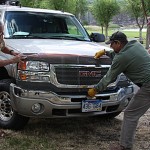
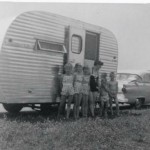


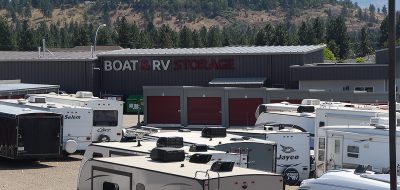
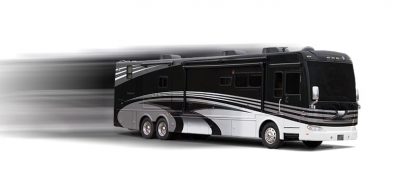
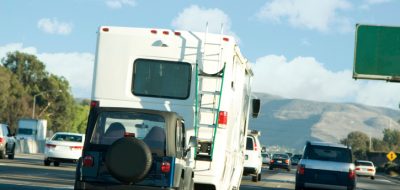
Lug_Nut
Jerry, Highway markings in North America are normally indicated in percent (%) of grade. This is based on elevation to distance ratio. Therefore 100% would be an impossible grade of 45′ forward 45′ elevation. One foot elevation in 100′ would equal 1% grade. Major road and interstates will generally never exceed a 6% grade, however there are secondary highways that may have 28% or more grade. Some city streets in very hilly towns can be substantially greater.
So, keep in mind, a 6% grade is common and should present no problems, however be aware of the distance of this. It is normally indicated also if it is over a mile or so. Just start out at a much lower speed than you would normally think and you will do fine. Hope this is the information you need.
Jerry
Just found your blog and the info on this piece is very helpful.
The question I have and been searching for is the grade %, what are they? Is it from 1% (not bad) to whatever the highest numbers is?
Just trying to understand what the scale is.
Thanks for any help.
Lug_Nut
Chuck, Yes many do keep their Jake or Pac Brake in the enabled position all the time, and this is fine. However, as it engages every time you lift your foot causing zero throttle, it may be better for fuel mileage to manually employ with the switch. This will allow you to coast while travelling through urban areas. Personally I rarely leave mine armed but prefer to switch as needed. Thanks for your input and question. Here’s a link from a blog I did in ’08 that you may find of interest. http://blog.rv.net/2008/03/real-world-steep-grade-techniques/
Chuck
Lug nut, thank you. About hill decent, Is it OK to use the coach jake brake or whatever it is called all the time or just when decending? Someone told me to just keep it on all the time.
Lug_Nut
Chuck, The Beaver is a nice coach. The ISC 350 produces 1050 ft. lbs. torque for that year. Though you are correct that higher outputs are available, the standard output performs very well. The transmission you have is probably an Allison 3000MH. The maximum torque on the tranny is 1200 ft. lbs. But, people have done it. Thank you for taking the time to comment and be part of this topic’s discussion.
Lug_Nut
Robin, Glad you found it of interest, Riding the brakes on steep grades may cause a failure well before wear is a consideration. Thank you for your input on this topic.
Lug_Nut
Darryl Todd, Great advise. In general I never follow that rule as I either have never climbed the opposite way or don’t remember which gear I was in when climbing. Thanks for the great tip.
Chuck
Hi–I have never been on a chat line before so bear wirh me. My wife and I just purchased a 2003 40 foot Beaver motor home diesel pusher. It has the 8.3 liter Cummins and I am thinking of chipping it for more power and torque. I have heard that the 8.3 liter is capable of much more horsepower than the 350 it has. I have a million questions but I will stop at this one for now. Thanks, Chuck
Robin
Love your advice and the other posters comments!
It was always ingrained upon me by my father that brakes were cheaper than transmissions, but everyone seems to agree that the lower gears (automatic), should be used when descending a mountain. Of course, not having any brakes left when you’re still on the mountain would be worse!
Darryl Todd
Be careful about using the same gear to go up and down hills. At least in Colorado roads often have a much different slopes on one side of a hill or pass than the other. We have a number of 5-6-7-8 percent grade mountain roads and on I-70 west of Denver the east bound lane goes from fairly rolling hills to a 7% grade with little warning. Even the semi drivers have to use the run-away truck ramps to stop once in awhile.
Darryl
Lug_Nut
Camping411 Guy, Yes there is nothing like experiencing the fear. It teaches you alot. Thanks for posting.
Camping411 Guy
I learned the hard way about descending or ascending grades (and a few hairpin curves to boot). I worked for a well known RV maker in CA. Took a trip with the fam and off roaded a 32ft RV rig. Saw some great scenery going up the back roads to highway 49, but will remember to follow the map even though my “boy scout” nose said there was a shorter way.
Lug_Nut
Don H., That is a great idea, turn off the AC. This will give you more available power for grade climbing and will also reduce the engine heat. Thanks for that great tip and for your input on this topic.
Don H.
Having control up and down hill is important. I have a 1998 Chevy Silverado and pull a 27′ Airstream. Keep an eye on the temp gauge going up, drop a gear if the temp climbs to high. I see signs on many hills that read, “turn off Air Conditioner when climbing hills”, this will take the load off the engine while pulling the hill, turn it back on for the down hill run.
Down hill I slow down to a comfortable speed, If the truck speed is 40mph, I stay near that posted speed. I drop the trans into 2nd, I touch the breaks maybe twice in the 6 miles to the bottom. This was on I-5 North bound into Kern County, Calif. I have used this same tactic on Hwy 168 up to and back from Shaver Lake, Calif. No problems on the down hill run. I did pass a boat trailer on the side one time with the brakes just a smokin’. He was only half way down.
Hope this helps in some way.
Lug_Nut
Bob Phelps, Great hearing from you and glad to hear you found this topic of interest. Thanks for posting.
Bob Phelps
Peter,
Thank you for all your advise. I have at times disconnected the Vue when going up
steep hills and had the wife drive it over the hill and down to the valley. Save wear and tear on the gas coach.
Thanks again,
Bob
Lug_Nut
Roy, I’m glad you enjoy the reading. Most of the larger diesels used in motor homes today, are set up to rev somewhat higher than their governed speed when zero power is applied combined with a lower gear. This RPM can be as much as 20% or so, faster than the governed speed. For these diesels, it does not hurt, in fact it is in the design and is suppose to over rev. I’m not familiar with the GM transmission of ’05 as to whether it also is designed that way. Perhaps a good GM tech could confirm this.
Thank you for your kind words and for your input on this subject.
Roy
Lug, LOVE your articles. I have learned alot.
We have a 2005 Chev. 2500 Diesel 4X4 with a Tow/Haul button at the end of the gear shift. It also is the Over Drive On/Off button as well. In May of this year I experienced the following: While going up a mountain, I had the Over Drive turned off, but still had the Tow/Haul activated. Did not shift into a lower gear while climbing. As I crested the mountain, I was at around 45 mph to go down. I use short, hard application on the brakes to keep the speed down. At some point in the decline, the transmission, I guess, shifted down a gear and the RPMS went into the RED. I had no Idea what was going on or what to do. What I did was brake short and hard to lower my speed to keep the RPMS out of the solid Red. This continued until I hit the bottom. I didn’t want to accelerate to increase the RPM’s. What did I do wrong ??
I didn’t think I would have to shift to a lower gear on the decline because I had the Magical Tow/Haul. Thanks for all the help you are providing us!
Lug_Nut
Ann, If you are manually shifting down, overdrive will be defeated temporarily anyway, therefore it does not matter whether it is on or off. In the mountains however, overdrive can cause the transmission to hunt, shifting in and out of OD. For that reason cancelling the OD probably makes sense. Thank you for your question and input.
Lug_Nut
John, I have often thought of something like that, in fact many times you have to block access to one side anyway. Thanks for the great suggestion, or at least I will take it that way. Your participation on this topic is both valuable and appreciated, thank you.
Ann
Reading Steve White’s comment about “kicking” automatic overdrive, does he mean taking the transmission off overdrive? Our Roadtrek will downshift on it’s own going down a grade, should I take it out of overdrive in this situation?
John
Hi Lug_Nut,
I recognize the second photo in your article to be around the Golden, BC area.
What memories after all those years hauling between Vancouver and Calgary!
Good point about using full jake on slick roads. Not so bad if you have the weight to make that rubber stick to the pavement. In winter time we never used the 3rd position on the jake in the hills.
The same thing with big power like 525 or 600. If you’re not careful you’ll spin out on snow or ice. We would engage a power divider when pulling steep slick hills.
That will make both axles drive and less chance to lose it.
Looking forward to part two next week!
Cheers,
John
Lug_Nut
David, The “Doing down the hill in the same gear” is good, but how do you remember exactly which gear it was or, many times, you have not been up here before. Any brake application that slows the unit creates heat. Bo not drag the brakes with light touch, you will only check the speed while increasing heat builds. Apply enough to get the vehicle down to the desired speed quickly then get off them. Thank you for your input.
Lug_Nut
David Rohlader, Great points. We will be touching on some of these next week. Thanks for the great input.
David
Go down the hill in the same gear that you went up in. Light application of the service breaks will be enough to keep from overspeeding the engine. Heavy application of the breaks will soon over heat them.
David Rohlader
There is an invisible hazard at high altitudes: reduced oxygen in the air for breathing! Also, blood pressure and tire pressure will increase as you go higher. Keep a check on both.
Lug_Nut
Bill, Sounds like you made out well in an otherwise bad situation. Good going. Thanks for sharing your experience and for your valued input.
Bill
I had an experience a couple of years ago crossing the mountains from California to Arizona when I had a feeling the brakes on my two dolly weren’t working and there was no place to have them checked until I got to AZ. I used my transmission to control my speed on the downhills to minimize using my brakes. It turned out the ground wire for the tow dolly had not been reconnected when I had a new engine battery installed.
I had no problems and it was a confidence builder in my driving ability. I also use the truck lane and my flashers: I’m not in a hurry, but don’t want to be a hazard to others.
Lug_Nut
Steve White, Glad you found the article of interest. Thank you for taking the time to participate on this topic and for your great input.
Steve White
I don’t know why this didn’t occur to me earlier, but I had to think about it to realize that it was important for me to kick my automatic overdrive going UP hill as well as down. I have a V10 gas Ford and it is easy for me to forget to that step even though I always downshift going down hill. Also, I like your tip about cresting the hill at the speed you want to maintain going down. And the one about flashers, too. Thanks!
Lug_Nut
Joe, Should be no issue. Controlling your truck’s speed can be assisted by downshifting the transmission to a lower gear. In most cases, following the “All Category” paragraph, should work fine. I’m glad you enjoy the articles. Thank you for your great question and valued input.
Joe
Mr. Nut
I have a 2500 dodge diesel with no pac brake or jake brake. Can down shifting the automatic trans. also help slow me down? Does it hurt the truck? I really enjoy your posts. Keep up the good work!
Lug_Nut
Alpenliter, In most, if not all states, including all of Canada, It is not only legal, it is the right thing to do. Realizing there may be cars or other vehicles, travelling at speeds much greater, I believe it is the right thing to do. In fact, if you have to move at a speed below the posted minimum or a speed you feel may impeed traffic, the emergency flashers are acceptable. Thank you for a great question and your very good input.
Alpenliter
Lug, is it ok/legal to engage your emergency flashers when going uphill/downhill at these greatly reduced speeds?